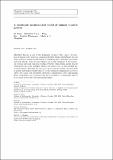Files in this item
A multiscale mathematical model of tumour invasive growth
Item metadata
| dc.contributor.author | Peng, Lu | |
| dc.contributor.author | Trucu, Dumitru | |
| dc.contributor.author | Lin, Ping | |
| dc.contributor.author | Thompson, Alastair | |
| dc.contributor.author | Chaplain, Mark A. J. | |
| dc.date.accessioned | 2018-02-17T00:33:00Z | |
| dc.date.available | 2018-02-17T00:33:00Z | |
| dc.date.issued | 2017-03 | |
| dc.identifier | 248040855 | |
| dc.identifier | d35a600a-aec8-4a47-8346-6529d6a88053 | |
| dc.identifier | 85013101806 | |
| dc.identifier | 000395156200001 | |
| dc.identifier.citation | Peng , L , Trucu , D , Lin , P , Thompson , A & Chaplain , M A J 2017 , ' A multiscale mathematical model of tumour invasive growth ' , Bulletin of Mathematical Biology , vol. 79 , no. 3 , pp. 389-429 . https://doi.org/10.1007/s11538-016-0237-2 | en |
| dc.identifier.issn | 0092-8240 | |
| dc.identifier.other | ORCID: /0000-0001-5727-2160/work/55379064 | |
| dc.identifier.uri | https://hdl.handle.net/10023/12739 | |
| dc.description.abstract | Known as one of the hallmarks of cancer (Hanahan and Weinberg in Cell 100:57–70, 2000) cancer cell invasion of human body tissue is a complicated spatio-temporal multiscale process which enables a localised solid tumour to transform into a systemic, metastatic and fatal disease. This process explores and takes advantage of the reciprocal relation that solid tumours establish with the extracellular matrix (ECM) components and other multiple distinct cell types from the surrounding microenvironment. Through the secretion of various proteolytic enzymes such as matrix metalloproteinases or the urokinase plasminogen activator (uPA), the cancer cell population alters the configuration of the surrounding ECM composition and overcomes the physical barriers to ultimately achieve local cancer spread into the surrounding tissue. The active interplay between the tissue-scale tumour dynamics and the molecular mechanics of the involved proteolytic enzymes at the cell scale underlines the biologically multiscale character of invasion and raises the challenge of modelling this process with an appropriate multiscale approach. In this paper, we present a new two-scale moving boundary model of cancer invasion that explores the tissue-scale tumour dynamics in conjunction with the molecular dynamics of the urokinase plasminogen activation system. Building on the multiscale moving boundary method proposed in Trucu et al. (Multiscale Model Simul 11(1):309–335, 2013), the modelling that we propose here allows us to study the changes in tissue-scale tumour morphology caused by the cell-scale uPA microdynamics occurring along the invasive edge of the tumour. Our computational simulation results demonstrate a range of heterogeneous dynamics which are qualitatively similar to the invasive growth patterns observed in a number of different types of cancer, such as the tumour infiltrative growth patterns discussed in Ito et al. (J Gastroenterol 47:1279–1289, 2012). | |
| dc.format.extent | 41 | |
| dc.format.extent | 5752140 | |
| dc.language.iso | eng | |
| dc.relation.ispartof | Bulletin of Mathematical Biology | en |
| dc.subject | Cancer invasion | en |
| dc.subject | Multiscale modelling | en |
| dc.subject | uPA system | en |
| dc.subject | QA Mathematics | en |
| dc.subject | QH301 Biology | en |
| dc.subject | RC0254 Neoplasms. Tumors. Oncology (including Cancer) | en |
| dc.subject | NDAS | en |
| dc.subject | SDG 3 - Good Health and Well-being | en |
| dc.subject.lcc | QA | en |
| dc.subject.lcc | QH301 | en |
| dc.subject.lcc | RC0254 | en |
| dc.title | A multiscale mathematical model of tumour invasive growth | en |
| dc.type | Journal article | en |
| dc.contributor.institution | University of St Andrews. Applied Mathematics | en |
| dc.identifier.doi | https://doi.org/10.1007/s11538-016-0237-2 | |
| dc.description.status | Peer reviewed | en |
| dc.date.embargoedUntil | 2018-02-16 |
This item appears in the following Collection(s)
Items in the St Andrews Research Repository are protected by copyright, with all rights reserved, unless otherwise indicated.

